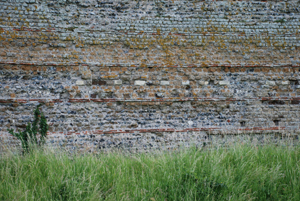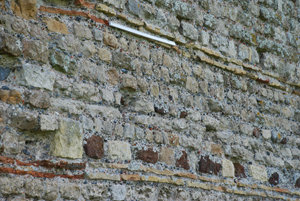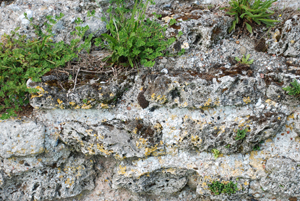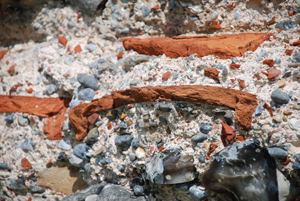POINTS ARISING...
(Graham's musings - right or wrong?)
ANCIENT GRAIN
How much Einkorn grain would 10,000 people need for one year?
Roman Soldier: Grain Ration (Polybius, 6, 39; 203-120BC) "The pay of the foot soldier is 5 1/3 asses a day; of the centurion 10 2/3; of the cavalry 16. The infantry receive a ration of wheat equal to about 2/3 of an Attic medimnus a month, and the cavalry 7 medimni of barley, and 2 of wheat; of the allies the infantry receive the same, the cavalry 1 1/3 medimnus of wheat, and 5 of barley." 1 Medimnus = ~6 modii = ~52 litres dry weight.
2/3 of a Medimnus is around 36 litres or 1 bushel (babylon.com)1 Bushel = ~27kg (Wheat) = ~15kg (Oats) = ~21kg (Barley) (answers.com) Here's my calculation reckoned on a Roman soldier's minimum ration of 27kg. per man per month.
I reckon this would make one loaf of bread per day.
One man - one year = 12 x 27 = 324 kg.
10,000 men - one year = 3,240,000 kg.
Mean Yield Values for European Wheats grown in Neolithic
(S.Gregg, Foragers and Farmers, University of Chicago Press, 1988)Einkorn Emmer/Spelt Spring 835 kg/ha Spring 1045 kg/ha Winter 645 kg/ha Winter 756 kg/ha
Assuming winter and spring harvests bring an annual average of 1480kg/ha (835+645 see above) that is a minimum of:
2189 hectares of Einkorn wheat.
(i.e. 5409 acres or 3180 football pitches)
If Barley, Rye and Legumes were grown as well... plus enough grain for the next year's sowing, plus a surplus and then one needs grazing for sheep, goats and cattle... it's rather a lot!
55BC
Just a line or two about Caesar's landings. As you may know the monthly tidal range in the channel, say Dover, is over 7 metres at times and usually a little more than 3 metres at its lowest while the Mediterranean tidal range can be zero in places, but usually never more than 40cm. This may have surprised or perplexed some of the Roman captains when they landed on the Kent beaches. August 26th was very late in the year to embark on any serious fighting but this was because he had been delayed by fighting with the Gauls. Anchoring in the shallows just off the beach or pulling up on the beach may have been the thing to do in the Med. but in the channel with a full moon was asking for trouble.
54BC
The next year he came better prepared, or did he? Obviously, some more forethought had been put into this landing, a lot was at stake - 40,000 men and 800 ships, it is said. But where to put all those ships? Caesar, still making the same mistake, apparently chose the beaches of Walmer, Deal and Worth again! He encountered the same trouble. It seems the Romans still had the same mindset used by the Greeks at Troy and Romans at Carthage in the Punic Wars: haul up on the beach and make a beachhead, build a palisade around the ships. This was nearly a military disaster in 54BC but just think how everything would be in a parallel universe had Caesar ignominiously died here!
43AD
Claudius got it right. The vast area around Richborough and Sandwich must have been a huge marsh or navigable mudflat but there was plenty of room for a fleet to shelter away from the ravages of tide, wind and currents of the Dover Strait. There was access inland too. This was a perfect place to harbour or beach 2000 assorted boats. Boats which may have had to be dragged out the water for a time. This is because they were used to dragging their boats from the water (i) for fear of the ship worm (Teredo navalis), (ii) to clean the cargo boats of detritus and animal faeces and (iii) the ancient ships were 'carvel' built and not 'clinker' (or clench) built as they were centuries later on and often are today.
Carvel construction means that the planks of wood making up the hull are put edge to edge over frame of the ship and mortise and tenonned with the tenons pegged with dowels (see boat left) as the ancient Greeks did with their triremes. Clinker or clench built means that planks are overlapped (just like a garden fence) like this rowboat I photographed on Deal beach. Carvel boats (clinker building was unknown at this time) were rugged, made of thick wood planks but may not have liked being in water all the time. They needed to be kept in sheltered water and Richborough (Rutupiae) must have been ideal - safe from the channel. These were probably clean-lined, heavy, ocean going ships rather than battering ram warships.
CONCRETE & STONE - where did it come from?
Opus caementicium
This is the general term used by the Romans for their concrete, i.e. binding agent, water and aggregate. What made their binding agent different from regular lime mortar (sand and quicklime i.e. Calcium Oxide) was the addition of a volcanic powder/dust called Pozzolona instead of the sand. This turned regular lime mortar, which hardens due to the Carbon Dioxide in the air, into something truly remarkable - a hydraulic cement (sets under water). Because regular lime mortar needs the presence of air it can only be used in thin layers, the CO2 can't get far inside the mix to set. The addition of this volcanic powder meant that the setting took place without the need for air, and Carbon Dioxide, to get to all parts of the concrete due to a chemical reaction between the volcanic ash and the slaked lime; it therefore set under water too. More importantly, large volumes could be cast which would set. This was the Roman secret. The crowning glory of Roman concrete technology was the cast concrete Pantheon dome in Rome. [Present Portland cement still contains lime and substances chemically similar to the Pozzolan ash and works in the same fashion.]
Opus signinum
was another kind of concrete that did not use Pozzolona volcanic ash but instead, originally, had a type of a pinkish orange kaolin clay from Signia in Latium added to it, hence its name. This too was a hydraulic concrete and waterproof. Some time later the Romans found that a type of concrete could be made with sand, lime and crushed terracotta bricks/tiles as a substitute for the kaolin clay from Signia. This is the concrete we often see in Britain since there was no volcanic ash or pink kaolin clay to be had in Britain. They may have imported small quantities, of course, although I doubt it. It is the pinkish (crushed brick) concrete we see in UK hypocaust systems. Vitruvius wrote extensively on it like many other architectural subjects.
Other forms of cement/concrete/masonry/brickwork
Opus reticulatum - uses shaped blocks of tufa set in opus caementicium . Looks like a diagonal net.
Opus testaceum (opus latericum) used bricks in opus caementicium .
Opus incertum: uses irregularly shaped stones in opus caementicium.
Opus spicatum is a type of paving made from small bricks laid in a zigzag pattern like a parquet floor.
Opus sectile is a type of mosaic using cut, polished stone or glass pieces.
Kentish Ragstone Much of the Roman stone building in Kent used ragstone and most of it came from the Maidstone area. There are several quarries around the town. The lack of suitable stone for building in East Kent may point to the reason why not so many villas, being made of wood, have been found in this area; while at west Kent, nearer Maidstone and Sevenoaks, rock is available for building and villas survive. Ragstone was available too on the escarpment overlooking Romney Marsh. The ragstone bearing bed runs along the line from Hythe to Maidstone to Westerham. Here it can be seen as ashlar blocks on the north wall at Richborough with flint cobbles below.
Ironstone Used here merely for a decorative chequerboard effect - alternate black and white blocks in the Richborough north wall. Not sure where this comes from in Kent although it is generally associated with chalk. I read somewhere it may have been found in Folkestone and Petham near Canterbury. On the Sussex border it was sometimes found and used for smelting iron. Note White yardstick.
Tufa This is a lightweight kind of limestone rich in carbonates often found in volcanic areas or mineral springs and it too is found in Kent at Westingbury near Maidstone. It was used for infilling walls in Roman times, it was also a good thing to add to concrete. This image shows cut tufa blocks (with plants) in the north wall at Richborough. Unusual for wall building since the Romans favoured it for its lightness (see holes) for ceilings and vaulting. Its presence here along with pieces of roofing tile below show that old buildings on the site were robbed to build the Saxon Shore fort walls.
Tiles Often called lacing or levelling or bonding courses, tiles are found in many Roman walls and are not only decorative but structural was well. Sometimes even roofing tiles (tegulae) are incorporated in walls when old structures are torn down. He is a inverted tegula from Richborough
Flint Flint cobbles are found all over the place especially in the Hythe and Folkestone areas on the beach. Any flints that might have been in fields have probably long since been removed (not too good for the ploughshare I guess). All the forts used flint cobbles in their walls
Greensand The Hythe Beds (sic) at Lympne (and elsewhere I imagine) provide some large Greensand blocks like the ones used in the Quenin Gate at Canterbury, some robbed greensand blocks can be seen in the arches of the church at Reculver too.
Click here to see old Geological map of Kent




